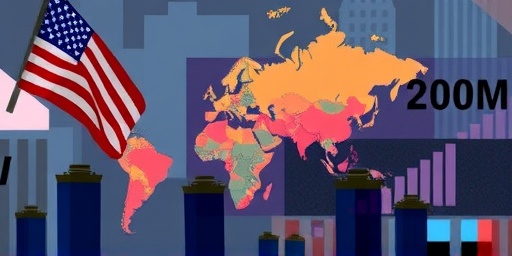In the heart of America’s suburbs, a once-comfortable middle-class family now skips grocery staples to make ends meet, a stark symbol of how nearly five years of unrelenting inflation has eroded the financial foundation of millions. As the US economy grapples with persistent price hikes, households earning between $50,000 and $150,000 annually—the backbone of the Middle class—are feeling the squeeze like never before, with everyday costs soaring 25% since 2020 according to the Bureau of Labor Statistics.
- Daily Essentials Turn into Luxury Items for Struggling Families
- Real Stories from the Frontlines: Middle-Class Voices Echo Economic Despair
- Inflation’s Economic Ripple Effects Reshape the US Workforce
- Political Tensions Simmer as Inflation Ignites Voter Anger
- Pathways to Relief: Policy Shifts and Economic Forecasts Signal Uncertain Horizons
Daily Essentials Turn into Luxury Items for Struggling Families
The cost of living has become a relentless foe for the Middle class, transforming routine purchases into calculated decisions. Inflation, which began its upward climb in early 2020 amid pandemic disruptions, has now persisted for almost five years, pushing the Consumer Price Index (CPI) to levels not seen in four decades. For a typical family of four in the Midwest, monthly grocery bills have jumped from $800 to over $1,100, forcing many to forgo fresh produce or opt for generic brands. “We used to enjoy family dinners with steak or salmon, but now it’s ground beef or pasta every night,” shares Sarah Jenkins, a 42-year-old schoolteacher from Ohio, whose household income hovers around $75,000.
Economic experts point to supply chain issues, energy price volatility, and wage stagnation as key culprits in this inflation saga affecting the US economy. The Federal Reserve’s aggressive interest rate hikes since 2022 aimed to curb inflation but have inadvertently slowed job growth in middle-class sectors like manufacturing and retail. A recent report from the Pew Research Center highlights that 62% of middle-class Americans report living paycheck to paycheck, up from 44% pre-pandemic. This financial strain isn’t abstract; it’s evident in rising credit card debt, which hit a record $1.13 trillion in Q3 2024, per the Federal Reserve Bank of New York.
Transportation costs add another layer of pressure. Gasoline prices, though fluctuating, average $3.50 per gallon nationwide—30% higher than in 2019—hitting commuters hard in sprawling suburbs where public transit is scarce. For families like the Jenkins, car maintenance and insurance premiums have risen 15-20%, compounding the burden. Housing, the largest expense for most middle-class households, remains a flashpoint: median home prices have surged to $420,000, while mortgage rates linger above 6.5%, locking many out of the market and trapping renters in escalating leases.
Real Stories from the Frontlines: Middle-Class Voices Echo Economic Despair
Across the nation, middle-class workers are voicing frustration that cuts through the statistics. In Texas, mechanic Raul Gonzalez, earning $62,000 yearly, describes how inflation has upended his plans for his daughter’s college fund. “We’ve saved for years, but with tuition costs inflating 8% annually and our savings yielding nothing after taxes, it’s slipping away,” Gonzalez told reporters during a community forum in Houston. His story mirrors a broader trend: a 2024 survey by the American Psychological Association found that 78% of middle-class respondents report heightened stress from financial worries, linking it directly to inflation’s toll on the cost of living.
In California, where the tech boom contrasts with widespread affordability woes, nurse Emily Carter exemplifies the squeeze on service professionals. At $95,000 income, Carter’s family still battles $2,500 monthly rent in Los Angeles, which has climbed 22% since 2020. “Inflation isn’t just numbers; it’s choosing between healthcare for my kids or saving for emergencies,” she says. These personal narratives underscore a deepening divide in the US economy, where the Middle class—once the engine of growth—now feels sidelined as wealth concentrates at the top. The Gini coefficient, a measure of income inequality, rose to 0.41 in 2023, the highest since 2016, per Census Bureau data.
Urban vs. rural divides amplify these challenges. In rural Pennsylvania, farmer Tom Reilly reports feed and fertilizer costs doubling due to global inflation pressures, squeezing his $80,000 operation. “The middle class in agriculture is vanishing,” Reilly laments, noting how small farms are consolidating under corporate giants. Quotes like these from diverse regions paint a vivid picture of how inflation permeates every corner of American life, fostering a sense of betrayal among those who feel the political class has failed them.
Inflation’s Economic Ripple Effects Reshape the US Workforce
Beyond household budgets, inflation’s five-year run is reshaping the US economy in profound ways, particularly for the middle class. Unemployment remains low at 4.1%, but underemployment—workers stuck in part-time or low-wage jobs—has ticked up to 7.8%, according to the Bureau of Labor Statistics. Many middle-class professionals, from educators to engineers, face stagnant wages that lag behind the 3.2% annual inflation rate, eroding purchasing power by an estimated 15% since 2020.
Corporate profits, meanwhile, have boomed: S&P 500 companies reported record earnings of $2.1 trillion in 2023, often passing on costs to consumers rather than absorbing them. This dynamic fuels accusations of ‘greedflation,’ where price gouging exacerbates the cost of living crisis. Economists like Joseph Stiglitz argue in a recent op-ed that without targeted policies, the middle class risks permanent shrinkage, potentially reducing the US economy’s GDP growth by 1-2% annually.
- Wage Growth Lag: Average hourly earnings rose 4.5% in 2024, but after inflation adjustment, real wages fell 1.2%.
- Savings Erosion: Household savings rates plummeted to 3.4%, the lowest since the Great Depression era.
- Retirement Insecurity: 401(k) balances for middle-income workers grew only 5% nominally, but inflation-adjusted returns were negative.
Healthcare costs, another inflation hotspot, have increased 18% over five years, with deductibles averaging $1,600 for middle-class plans. This forces many to delay treatments, worsening health outcomes and productivity in the workforce.
Political Tensions Simmer as Inflation Ignites Voter Anger
As the 2026 midterms loom, inflation’s grip on the middle class is igniting political fires, reshaping the landscape of US politics. Polls from Gallup show 65% of voters cite the economy as their top concern, with cost of living topping the list for middle-class demographics. Incumbent parties face backlash: approval ratings for economic handling hover at 38%, per a September 2024 Quinnipiac survey, as families blame Washington for failing to tame inflation.
Democrats tout infrastructure investments like the 2021 Bipartisan Infrastructure Law, which pumped $1.2 trillion into jobs, but critics argue it hasn’t trickled down enough to offset inflation. Republicans, emphasizing deregulation, point to Biden-era spending as the inflation culprit, vowing tax cuts in their platform. “The middle class is paying the price for reckless fiscal policy,” said GOP strategist Karl Rove in a recent interview, predicting a wave of populist candidates capitalizing on economic discontent.
Key battleground states like Michigan and Pennsylvania, where manufacturing middle-class jobs have declined 12% amid inflation-driven offshoring, could swing on these issues. Advocacy groups like the Middle Class Alliance are mobilizing, with petitions garnering 500,000 signatures for price controls on essentials. Political analysts warn that without relief—such as expanded child tax credits or affordable housing initiatives—voter turnout could surge among disillusioned middle-class blocs, potentially flipping congressional majorities.
Emerging debates include universal basic income pilots in states like California, aimed at buffering inflation’s impact, though fiscal hawks decry them as inflationary. Internationally, the US’s predicament contrasts with Europe’s targeted subsidies, prompting calls for bipartisan action. As one senator noted anonymously, “Inflation isn’t partisan; it’s existential for the middle class.”
Pathways to Relief: Policy Shifts and Economic Forecasts Signal Uncertain Horizons
Looking forward, the middle class’s fate hinges on evolving US economy trends and political will. The Federal Reserve projects inflation cooling to 2.5% by mid-2025, but experts like those at the Brookings Institution caution that supply-side reforms—such as trade policy tweaks and energy independence pushes—are essential to sustain this. If achieved, real wage growth could rebound, easing cost of living pressures and bolstering middle-class stability.
Yet risks abound: geopolitical tensions, including ongoing conflicts in Ukraine and the Middle East, could reignite energy inflation, pushing gas prices toward $4 per gallon. Domestically, the 2026 midterms may yield a divided Congress, stalling reforms like the proposed $15 minimum wage hike, which economists estimate could lift 1.3 million out of poverty but add to short-term inflationary pressures.
Optimistic scenarios include tech-driven efficiencies lowering goods prices and AI boosting productivity in middle-class jobs, potentially adding $2.6 trillion to GDP by 2030 per McKinsey reports. Community initiatives, from food co-ops to skill-training programs, offer grassroots relief. For families like the Jenkins and Gonzalez, hope lies in voting with their wallets—demanding policies that prioritize the middle class over corporate interests.
Ultimately, breaking inflation’s five-year stranglehold requires a unified approach: fiscal discipline, innovation investment, and empathy for those bearing the brunt. As the US economy teeters, the middle class’s resilience will test the nation’s democratic fabric, setting the stage for a pivotal political reckoning.









